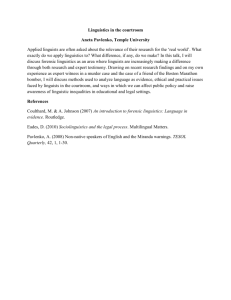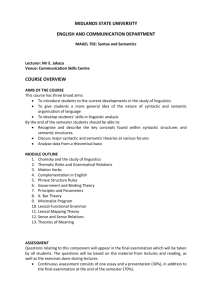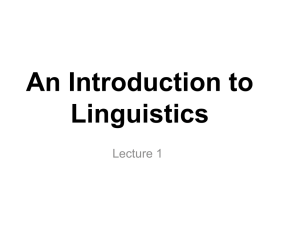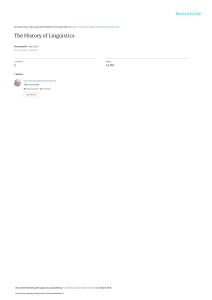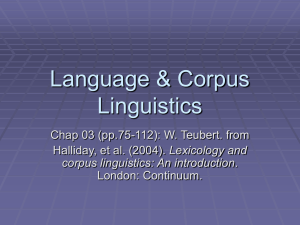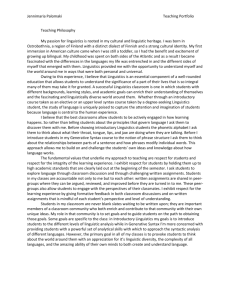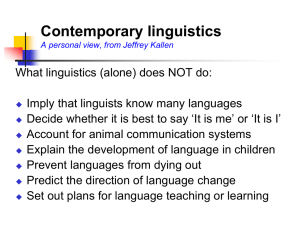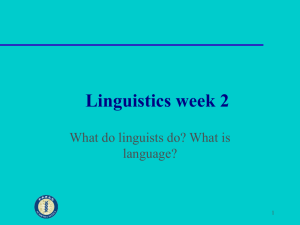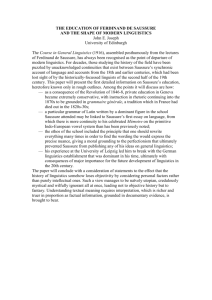Introduction to Linguistics 13 Who`s who in linguistics
advertisement
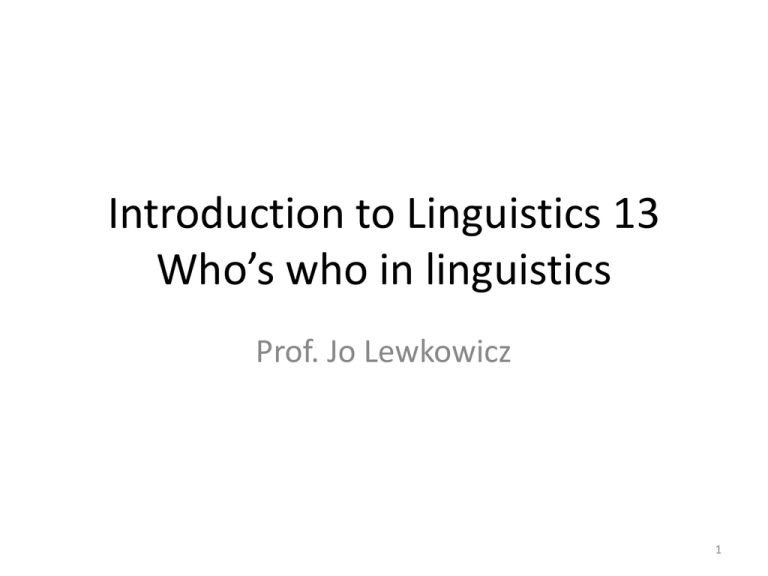
Introduction to Linguistics 13 Who’s who in linguistics Prof. Jo Lewkowicz 1 The early linguists • Pãņini (circa 5th century BC) – Indian linguist – Nothing is known about his life – His work Astãdhayãyi is a culmination of his studies on Sanskrit grammar & phonology – He looked at the way words were ‘glued together’ and how the bits affected pronunciation • impenetrable = in + penetrate +ble – Gave insights to Chomsky 2 The Greek & Roman linguists • Aristotle (384-322 BC) – Divided the sentence into 2 parts: subject + predicate • The king of Persia (S) took a vast army to Greece (P) • Dionysius Thrax (2nd to 1st centuries BC) – Identified 8 parts of speech • • • • • • • Nouns Verbs Articles Prepositions Conjunctions Adverbs Particles – Thrax’s work became the basis of all grammar description in Europe until well into 20th century (i.e. forms basis of traditional grammar) • Roman scholars learned of the work done in Greece in mid 2nd century BC and began to apply it to Latin – Culminated in a description of grammar completed by Priscian in 6th c AD 3 The birth of historical linguistics • Towards the close of 18th century linguists such as Franz Boop (1791-1867), Rasmus Rusk (1787-1832) & Jakob Grimm (1785-1863) began to realise that languages resembled one another and therefore many developed from a common core – E.g. Indo-European language family consisting of 10 separate branches, including Old Germanic languages from which English derives and Balto-Slavic languages which includes Polish • Study of historical linguistics, i.e. how languages have developed and changed, began to be the primary point of interest 4 Development of general linguistics • Focus on historical linguistics in Europe continued for approx a century • Towards end of 19th c did the study of language structure begin to reassert itself – that is how languages are put together and how they work • Prominent at the time were – German: Georg von der Gabelentz (1840-1893) – Poles: Jan Baudouin de Courtenay (1845-1929) & Mikołaj Kruszewski (1851-1887) 5 Ferdinand de Saussure (1857-1913) • Father of modern linguistics • His worked was put together and published by his students after his death • Introduced several key concepts into linguistics – Distinguished between the study of language at a particular point in time (synchronically) and over a period of time (diachronically) – Distinguished also between individual acts of speech (parole) and the language (langue) shared by members of a speech community • de Saussure’s approach was called structuralism and has been influential since 1920’s 6 The Prague Circle • This group of linguists congregated in Prague after the Russian Revolution • Developed structuralist ideas in a number of directions over next 2 decades • Particulary prominent were: – Nicolai Trubetzkoy (1890-1938): ‘Principles of Phonology’ – Roman Jakobson (1896-1992) – after 1938 fled West & settled in the USA • Contribution = role of context in language; relationship between form and function; work on language universals & how these influence the sequence of L1 acquisition 7 Origins of American linguistics • Started as a result of an interest in the dying cultures of native Americans. • Franz Boas (1858-1942) realised that to understand a culture one needs to know the language. – Influenced a generation of anthropologists to learn and record dying languages • One of Boas’ most eminent students was Edward Sapir (1884-1939). He was interested in the relations between language and culture. • Sapir’s student, Benjamin Lee Whorf (1897-1941) proposed the Sapir-Whorf Hypothesis which states that the structure of a language will, to some extent determine how its speakers perceive the world (Navaho people see things in terms of geometrical structures for which they have numerous terms, while English speakers see things in terms of other objects). The hypothesis has been largely discredited. 8 Leonard Bloomfield (1887-1949) • • • • • • • Bloomfield is considered the father of modern linguistics Anthropologist by training – he was interested in Native American cultures Published seminal work ‘Language’ in 1933 Found traditional descriptions of languages based on Latin did not fit the languages he was studying Developed his own structural form of analysis which could account for the differences which exist between languages Argued that each language needed its own structural analysis Also wrote about how languages are learned. – – brought together his structuralist views on language with behaviourist psychology (dominant at the time) More interested in form than in meaning (in line with behaviourism and with the current teaching methodology of audiolingualism) 9 Noam Chomsky (b. 1928) • Political activist as well as a linguist • Chomsky’s work is best know for 2 areas of his work: – Transformational-generative grammar, i.e. Languages are rule bound and we can generate rules that will only allow grammatical structures to be generated (and not ungrammatical ones). Saw meaning and form as separate (e.g. Colorless green ideas sleep furiously) – Criticised the work of B.F. Skinner who believed that language learning was a matter of stimulus and response, showing that language acquisition is not a matter of habit formation and must be genetically motivated (LAD). All human being inherit a Universal Grammar • His approach to language analysis and LA can be described as ‘mentalist’ of ‘formalistic’. 10 Michael Halliday (b. 1925) • Most influential linguist active today, particularly in the U.K. & Australia • Systemic-functional linguistics which attempt to establish relationships between language form and language function (compare with ideas of Chomsky that these 2 are separate systems) • Seminal account of child language development (based on his own child – Nigel), suggested that a child’s language develops from a primitive protolanguage to a fully fledged form. 11 Stephen Pinker (b.1954) • On basis of what scientist have been able to ascertain from people with language disorders, Pinker has suggested that our language faculty consists of 2 large, important and distinct components: – Word storage (we store new words one by one) – Rules (we gradually construct rules as we acquire language) • This is in agreement with Chomsky, that predisposition for learning a language is innate – it is part of our genetic makeup. 12
